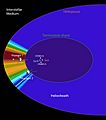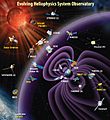Heliosphere facts for kids
The heliosphere is like a giant bubble in space. It's "blown" out by the solar wind from our Sun. This bubble protects our Solar System from the gas and dust found between stars, called the interstellar medium. Even though some neutral atoms from outside can get in, most of the stuff inside the heliosphere comes from the Sun itself.
The solar wind travels super fast, over a million kilometers per hour, for billions of kilometers! But as it gets further from the Sun, it starts to slow down when it meets the interstellar medium.
There are a few important places in this bubble:
- The termination shock is where the solar wind suddenly slows down a lot.
- The heliopause is the very edge of the heliosphere. It's where the pressure from the solar wind and the interstellar medium balance out.
- The bow shock is where the interstellar medium slows down as it bumps into the heliosphere. Think of it like a boat making a wave in front as it moves through water.
What is the Solar Wind?
The solar wind is a stream of tiny particles and magnetic fields that constantly flow out from the Sun. These particles are actually charged atoms, called ions, that come from the Sun's outer atmosphere, the corona.
As the Sun spins around (it takes about 27 days for one full turn), the magnetic fields it sends out get twisted into a spiral shape. Changes in the Sun's magnetic field can be carried by the solar wind all the way to Earth. These changes can sometimes cause magnetic storms in Earth's magnetosphere, which is our planet's own magnetic shield.
In 2005, a special instrument on the Solar and Heliospheric Observatory (SOHO) spacecraft made an interesting discovery. It showed that the heliosphere isn't perfectly round or symmetrical. It's actually a bit squished or distorted. Scientists think this is probably because of the magnetic field of our galaxy that surrounds it.
Images for kids
-
Energetic neutral atoms map by IBEX. Credit: NASA / Goddard Space Flight Center Scientific Visualization Studio.
-
The Sun photographed at a wavelength of 19.3 nanometers (ultraviolet)
See also
 In Spanish: Heliosfera para niños
In Spanish: Heliosfera para niños












